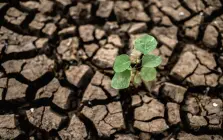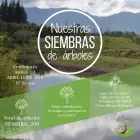Any action we want to take in nature, such as reforestation planting to convert territory into a forest: new, protective or productive, requires a management plan that, through specific forest maintenance actions, allows these species to survive, develop and fulfill the objective of strengthening the biological richness these forestry interventions are carried out.
Red de Árboles ONG establishes protocols for tree planting and forest maintenance on land donated by governmental and private entities that join in environmental reforestation, for different uses such as change of land use, reforestation, creation of living fences, or environmental corridors.
Forestry maintenance plan:
In the first place, trees should be chosen according to the altitude of the terrain, to ensure that they are planted with species that are suitable and resistant to the temperature of the chosen site. For example, planting a frailejón at an altitude of 3,600 meters means a loss of that species, because it will not survive, the same thing that would happen to a coastal palm planted in a moor, it would be burned by the extreme cold, these are minimum knowledge necessary for a successful planting maintenance process and that meets the planted objective.
On the other hand, it is necessary to take into account that when soil is highly eroded, either by deforestation, extensive use for cattle, crops, mining, among others, it is necessary to bring fertilized soil and make the hole with a larger than average diameter, so that the roots absorb the nutrients from the composted soil. Once the planting process of native species that range between 80 and 120 centimeters high is finished, it is essential to carry out preventive maintenance during the first three years of planting.
Having a forest management plan is essential to guarantee the biological and phytosanitary success of the plantation. Therefore, the management plan should establish activities that lead to the planting objective:
- It is necessary to visit the site at certain times, weekly, monthly, bimonthly, or quarterly, to ensure that the plants are developing normally and/or to detect in time problems that may affect their survival.
- Performing enhancement pruning so that the tree does not spread if there are many trees nearby.
- Root pruning the species was planted to move the soil, oxygenate it and allow nutrients to fix in the roots of the tree.
- Permanent weeding control should be carried out until the plant is established enough to overcome competition for nutrients and water.
- During the dry season, irrigation should be carried out continuously for the survival of the plants until the new rainy season begins.
In the case of nutritional deficiencies, corrective fertilization should be carried out.
Finally, technology is used to facilitate the monitoring of species. The Fundación Red de árboles, together with the company Netwoods, has developed software with a cell phone application called RDA MONITOR that allows monitoring of plantings in real-time, captures the geo-position of the tree, takes a photo from the same application, shows the growth and condition of the forest, and at the same time, with the data recorded, offers tools for decision-making on management plans and, with this innovation, achieves the objective of optimizing resources in forestations and automating forest maintenance processes.
Not a forestry maintenance plan implies an unsuccessful execution of resources, since the objective of the plantation would not be fulfilled. In a tree plantation, it is normal for up to 10 percent of the species to be lost; however, if an adequate forest maintenance plan is not in place, the risk of loss is almost 100 percent.
Source consulted: https://www.reddearboles.org/















 Fundación
Fundación